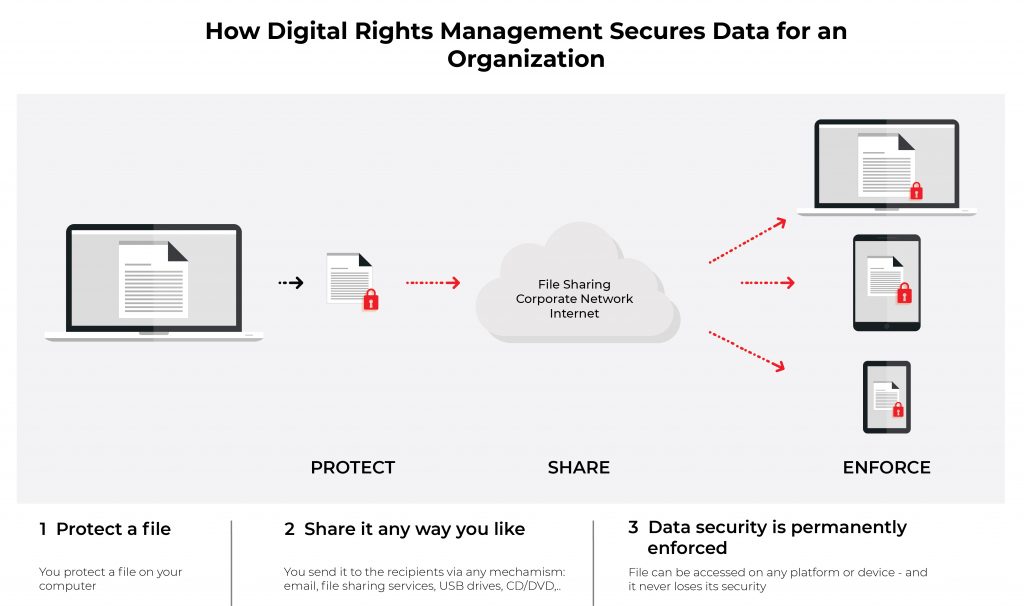- What is Digital Rights Management?
In a way, digital rights management allows publishers or authors to control what paying users can do with their works. For companies, implementing digital rights management solutions or processes can help to prevent users from accessing or using certain assets, allowing the organization to avoid legal issues that arise from unauthorized use
How Digital Rights Management Works
Most of the time, digital rights management includes codes that prohibit copying, or codes that limit the time or number of devices on which a certain product can be accessed.
Publishers, authors, and other content creators use an application that encrypts media, data, e-book, content, software, or any other copyrighted material. Only those with the decryption keys can access the material. They can also use tools to limit or restrict what users are able to do with their materials.
There are many ways to protect your content, software, or product. DRM allows you to:
Restrict or prevent users from editing or saving your content.
Restrict or prevent users from sharing or forwarding your product or content.
Restrict or prevent users from printing your content. For some, the document or artwork may only be printed up to a limited number of times.
Disallow users from creating screenshots or screen grabs of your content.
Set an expiry date on your document or media, after which the user will no longer be able to access it. This could also be done by limiting the number of uses that a user has. For instance, a document may be revoked after the user has listened ten times or opened and printed the PDF 20 times.
Lock access only to certain IP addresses, locations, or devices. This means that if your media is only available to US residents, then it will not be accessible to people in other countries.
Watermark artworks and documents in order to establish ownership and identity.
Digital Rights Management Use Cases
1. Digital rights management allows authors, musicians, movie professionals, and other creators to prevent unauthorized use of their content
2. Digital rights management can help companies control access to confidential information. They can use these technologies to restrict access to sensitive data, while at the same time allowing it to be shared securely. Furthermore, having DRM technologies makes it easier for auditors to investigate and identify leaks. When used in a business setting, digital rights management may be called by a different name, such as information rights management or enterprise rights management
3. Digital rights management ensures that digital work remains unaltered.
Benefits of Digital Rights Management
1. Digital rights management educates users about copyright and intellectual property.
2. DRM helps make way for better licensing agreements and technologies.
3. Digital rights management helps authors retain ownership of their works.
4. Digital rights management helps protect income streams
5. Digital rights management can help secure files and keep them private
https://digitalguardian.com/blog/what-digital-rights-management
- Digital Rights Management (DRM) Solutions Explained
DRM solutions are software programs created to help companies protect and control their valuable digital content, whether it's documents, videos, images or audio files.
Benefits of Digital Rights Management (DRM) Software
Prevent piracy of your valuable intellectual property
Control the access to your content so only authorized individuals will see it
Allow your authorized users to access your protected content without the need for plug-ins or 3rd party apps
Apply various content controls to your content such as print and copy restrictions, watermarks, data limits, device limits, and more
Activate or revoke user access at any time
Track the activity of your users with simplified dashboards and detailed analytics reports
Industries that can Benefit from DRM Software
Associations & Professional Training Organizations
Whether you work for an association or a professional training organization, you need to know how to send documents securely and share your valuable training videos with your members and trainees.
Market Research & Data Intelligence
Countless hours go into market research in the commodities, oil and gas, medical, pharmaceutical, technology, and other industry sectors. It would be a shame for those hours to become worthless when reports, videos, price sheets, forecasts, and more get leaked online or shared with others who haven’t paid for the report or haven’t subscribed to your service
Financial Service
Financial institutions such as asset management companies, hedge funds, insurance companies, private equity firms and other investment management organizations need to protect the interests of their clients, their shareholders, and themselves
Solutions like Dropbox or data rooms only secure the 'house' or 'portal' where clients can access the files, but they don't protect the individual files or documents once they're downloaded.
A quality DRM solution will protect the files when they're downloaded, no matter where they're stored or saved
Standards Organizations
That’s why companies and trades professionals pay associations and trade organizations membership fees and subscription dues to access the standards documents or training materials they need to be successful.
Media & Publishing
For professionals in the media & publishing industry, content is everything. Protecting that content is key to protecting their bottom line. While they need to share it with their subscribers, leaks, piracy, and unauthorized access renders their subscription fees worthless. Why pay for what you can get for free? The same is true for authors who self-publish their books
https://www.vitrium.com/what-is-digital-rights-management-drm-and-how-does-it-work-for-you




https://jaxel.com
ReplyDelete